Carcassonne, named after a well fortified town in southern France, is a tile laying game that is a lot more strategic than I initially gave it credit for. I have to admit that this was the first tile laying game that I ever played…in fact…this game is what inspired me to take a look into the board game, Acquire.
Carcassonne tasks players with building a landscape of epic proportions. This landscape will start as a single tile and gradually grow to include cities, roads, cloisters, and fields. Each player will be placing these tiles in ways that would most benefit them so that they can score points. The person with the most points at the end of the game wins. Before I get ahead of myself, let’s take a quick look at the components and rules before heading into the review.
Components
Tiles – All of the tiles are square-shaped, but their contents can change from tile to tile. There is one starter tile that has a different colored back so that it can be easily identified.
Followers – Your followers are represented by meeples. Meeples are short for, “my people”, and serve as the way players earn points. They also double as a score marker for the score track.
Score Track – Players will be earning points throughout the game. As they do, they’ll be moving their colored follower along the track. You’ll more than likely pass the maximum point value of “50″, so you may want to create your own ways to keep track of what “pass” you are on. You could, for example, lay down your follower rather than stand him up, to indicate that you are on your second pass.
Setup
1) Place the starter tile in the middle of the table, face up.
2) Each player picks a color and gets all of the followers of that color.
3) Each player places one follower on the score track.
4) All the remaining tiles are shuffled and placed into stacks, face down.
Gameplay
Players take turns drawing a tile and placing it next to an existing tile on the board. The sides / borders of the tiles must match…that is…roads must connect to roads, cities must connect to cities, and etc.
After placing a tile, that player has the option of placing one of their followers on that tile in an attempt to score. There are four ways followers can score, based on what feature they are placed on.
Knight – When a follower is placed on the city portion of a tile, it is called a knight. When a city is completed, the follower is removed and given back to the player, and that player earns two points per tile that the city occupies plus two points per pennant icon. Scoring is immediate.
Thief – When a follower is placed on the road portion of a tile, it is called a thief. When a road is completed, or goes from point to point, the follower is removed and given back to the player. That player earns one point per tile that contains that stretch of road. Scoring is immediate.
Monk – When a follower is placed on the cloister portion of a tile, it is called a monk. When a cloister is completed, or surrounded by one tile in all eight directions, that follower is removed and given back to the player. That player earns nine points, one point per tile. Scoring is immediate.
Farmer – When a follower is placed on the field portion of a tile, it is called a farmer. That farmer stays there, laying down, until the end of the game. For each completed city the farmer’s field touches, they earn three points. Again, scoring is NOT immediate and only occurs at game end.
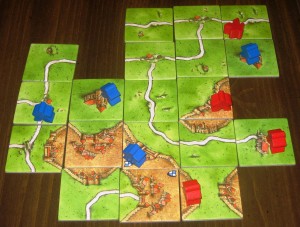
Followers can fill various roles, but you’ll want to assign them to the ones that would benefit you most.
During the game, there are a few rules to keep in mind when placing followers. The main one is that you can’t assign a follower on a feature that someone else already has claimed. You couldn’t place a thief onto a road already occupied by another thief, for example.
There are instances where two separate segments of a feature occupied by different colored followers end up connecting. In this case, the person with the MOST followers on that completed feature earns the points. In case of a tie, all players get the points.
You can also only place one follower per turn and you cannot take followers back until they are scored…so place your followers wisely!
The game ends when all of the facedown tiles have been used. Additional scoring takes place at this point, which allows players to score the followers on the features that were not completed. Players also score their farmers and finally compare their final scores. The player with the most points at the end of the game wins.
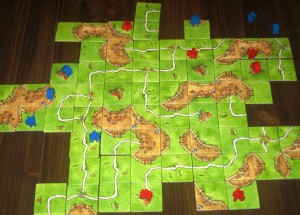
For giggles, I moved one tile into an illegal position…can YOU find the tile that was “placed incorrectly?”
I know I skimmed the rules a bit, but the above should give you an idea of what you would be in for. You can check out the full rules here: Carcassonne Rules.
The Review
As I mentioned above, I was very surprised by how much this game grew on me. At first, I was skeptical by the fact that you didn’t have a hand and were at the mercy of whatever tile you drew. In the beginning of the game, you won’t have that many choices in terms of placement, but towards the end, you’ll be trying to screw up your opponent’s scoring chances while trying to resolve your own.
Keeping along those lines, I personally enjoyed how strategic the game turned out to be. I was constantly thinking of ways to extend my son’s city (the one he had a follower on) so that he’d never be able to complete it. He’d still earn one point per city tile at game end, but that was significantly less than the two points per tile he could have earned.
Resisting the urge to place all of my followers in the beginning became a real challenge. I saw a lot of potential fields that future cities might connect to, but I had to make sure I had enough in reserve to score on the more immediate opportunities. Since you and your opponent are limited to how many followers you have, it becomes a battle of wits to see who claims what first and who is able to save enough for when it counts.
Out of all of the game mechanics, the scoring was the hardest for me to pick up on. At times, I was scratching my head on how farmers scored and what fields were considered theirs. Once you overcome this initial learning curve, play is relatively fluid. Luckily, the manual is fairly easy to understand when trying to put it all together.
I should also mention that this game has a TON of expansions, which shoots up this game’s replay value tenfold. It seems like there is always something new to keep the game fresh and interesting. Not all of the expansions will appeal to everyone, but having the option alone is a plus in my book.
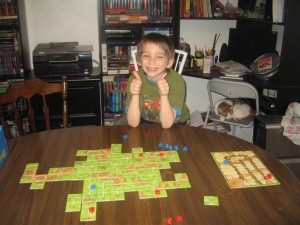
Thumbs up for figuring out which tile was incorrectly placed. (The tile in the lower right, pulled from its fake position in the lower right)
Carcassonne is a great game to introduce to players that are new to the wonderful world of board games, especially if you have an experienced player on hand to help with the scoring and flow of play. It’s also a great game for players of all ages (within reason), so if you are in the market for something relatively easy that provides a fair amount of depth, then you may want to look into this game further.
Final Verdict: 7/10
—

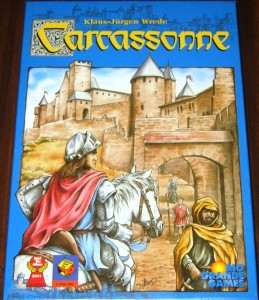
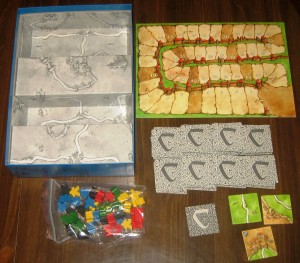
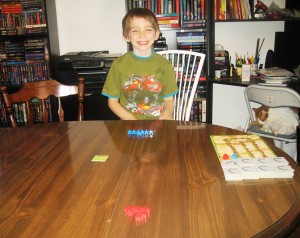
How can I get invited to http://carcassonne-city.blogspot.com/ to see other carrcassonne info??
I’ve never heard of that site. The link to the manual I posted in the article should help you see more about the game. You can also find more information on BoardGameGeek here: http://www.boardgamegeek.com/boardgame/822/carcassonne.